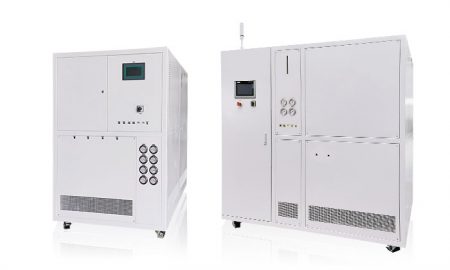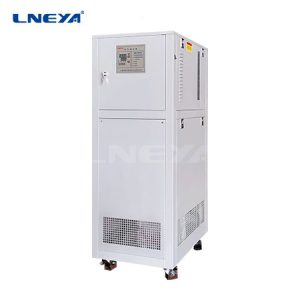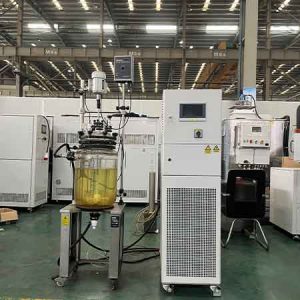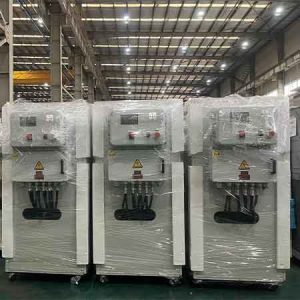Battery Cooling System
Contacte-nos hoje para obter a solução perfeita de controlo da temperatura
The heat-related problems of batteries are the key factors that determine their performance, safety, life and use. First, the temperature level of a Li-ion battery directly affects its energy and power performance in use. When the temperature is low, the available capacity of the battery will rapidly decay. Charging the battery at a too low temperature (such as below 0°C) may cause an instantaneous overcharge of the voltage, resulting in internal lithium precipitation and a short circuit. . Second, the heat-related issues of Li-ion batteries directly affect the safety of the batteries. Defects in the manufacturing process or improper operation during use may cause local overheating of the battery, which in turn causes a chain exothermic reaction, eventually causing serious thermal runaway events such as smoke, fire or even explosion, threatening the lives of vehicle drivers and passengers.
In addition, the operating or storage temperature of lithium-ion batteries affects their service life. The suitable temperature of the battery is about 10 ~ 30°C, too high or too low temperature will cause a rapid decay of battery life. The large size of the power battery makes the ratio of its surface area to volume relatively smaller, and the internal heat of the battery is not easily dissipated, and problems such as uneven internal temperature and excessive local temperature rise are more likely to occur, thereby further accelerating battery attenuation and shortening battery life.
The battery thermal management system is one of the key technologies to deal with the heat-related problems of the battery, and to improve the performance, safety and life of the power battery.

The main functions of the sistema de arrefecimento da bateria include:
● Effective heat dissipation when the battery temperature is high to prevent thermal runaway accidents;
● Preheat the battery when the temperature is low to increase the battery temperature to ensure the charging and discharging performance and safety at low temperature;
●Reduce the temperature difference in the battery pack, suppress the formation of local hot spots, prevent the battery from decaying too quickly at high temperature locations, and reduce the overall life of the battery pack.
The temperature environment in the battery pack has a great impact on the reliability, life and performance of the battery cell. Therefore, it is particularly important to maintain the temperature in the battery pack within a certain temperature range. This is mainly achieved through cooling and heating. Here we briefly introduce three cooling methods: air cooling, liquid cooling, and direct cooling.
Air-cooled battery cooling system
Air cooling uses low-temperature air as the medium and uses heat convection to reduce the battery temperature. It is divided into natural cooling and forced cooling. This technology uses natural wind or fan to cool down the battery with the evaporator that comes with the car. The system structure is simple and easy to maintain.
Liquid cooling battery cooling system
Liquid cooling technology uses liquid convection heat exchange to take away the heat generated by the battery and reduce the battery temperature. The liquid medium has a high heat transfer coefficient, large heat capacity, and fast cooling speed. While reducing the temperature and improving the consistency of the temperature field of the battery pack, the volume of the thermal management system is relatively small. The form of the liquid cooling system is more flexible: the battery cells or modules can be immersed in the liquid, cooling channels can also be set between the battery modules, or a cooling plate can be used at the bottom of the battery. When the battery is in direct contact with the liquid, the liquid must be insulated (such as mineral oil) to avoid short circuits. At the same time, the airtightness requirements of the liquid cooling system are also relatively high. In addition, it is mechanical strength, vibration resistance, and life requirements.
Direct cooling battery cooling system
Direct cooling (refrigerant direct cooling): use the principle of latent heat of evaporation of refrigerant (R134a, etc.) to build an air conditioning system in the vehicle or battery system, install the evaporator of the air conditioning system in the battery system, and the refrigerant in the evaporator Evaporate and quickly and efficiently take away the heat of the battery system, so as to complete the cooling of the battery system.
Correio eletrónico: info@lneya.com ID WeChat: +8615251628237 WhatsApp: +86 17851209193
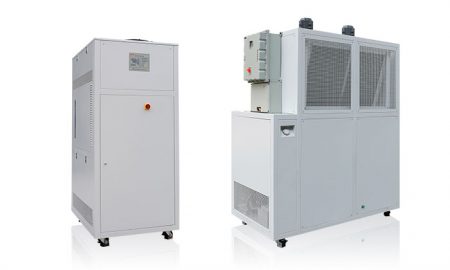 Chillers de precisão / Chillers pequenos (Desenhos personalizados)
Chillers de precisão / Chillers pequenos (Desenhos personalizados)
O refrigerador pode ser amplamente utilizado em várias indústrias e laboratórios, e suporta um design personalizado.
| Gama de temperaturas | -18°C ~ +30°C | Série +5°C ~ +35°C |
| Capacidade de arrefecimento | 0,35 ~ 0,9kW | 1,8 ~ 50kW |
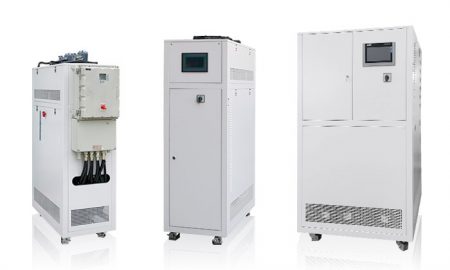
Chillers de recirculação (Desenhos personalizados)
Nosso resfriador de recirculação adota tecnologia de refrigeração de baixa temperatura, a temperatura é tão baixa quanto -120 ℃ e vários acessórios são personalizáveis.
| Gama de temperaturas | Série -25°C ~ +30°C | Série -45°C ~ +30°C | Série -60°C ~ -20°C | Série -80°C ~ -20°C | Série -120°C ~ -70°C |
| Capacidade de arrefecimento | 0,8 ~ 30kW | 0,75 ~ 12kW | 0,4 ~ 6kW | 0,2 ~ 6kW | 0,3 ~ 5kW |
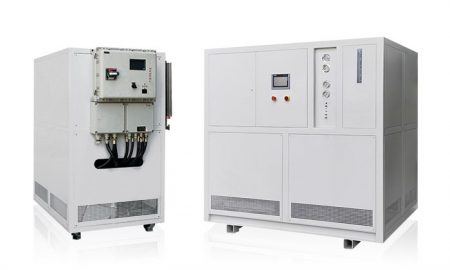
Chillers de baixa temperatura (Desenhos personalizados)
Somos especializados na produção de refrigeradores de baixa temperatura com uma gama de controlo de temperatura tão baixa como -150°C, que pode satisfazer as necessidades de refrigeração de diferentes indústrias.
| Gama de temperaturas | Série -25°C ~ -5°C | Série -45°C ~ -10°C | Série -60°C ~ -10°C | Série -80°C ~ -30°C | Série -110°C ~ -50°C | Série -150°C ~ -110°C |
| Capacidade de arrefecimento | 12 ~ 360kW | 6 ~ 180kW | 6 ~ 180kW | 4 ~ 180kW | 2 ~ 120kW | 2,5 ~ 11kW |
Simulação da temperatura para o ensaio da qualidade do veículo: ensaio da duração da bateria, banco de ensaio do injetor/motor de combustível, ensaio do airbag, banco de ensaio de componentes, etc.
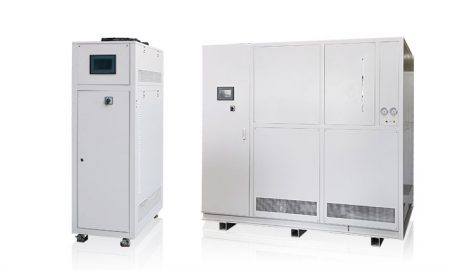
Adequado para o controlo preciso da temperatura de componentes electrónicos. No fabrico de componentes electrónicos de semicondutores para ambientes agressivos, as fases de montagem de embalagens IC e de ensaios de engenharia e produção incluem ensaios térmicos electrónicos e outras simulações de ensaios ambientais.

Chillers para armazenamento de energia(Desenhos personalizados)
Liquid Cooling Solutions For Battery Energy Storage Systems
| Gama de temperaturas | -45°C ~ +55°C |
| Capacidade de arrefecimento | 45kW |
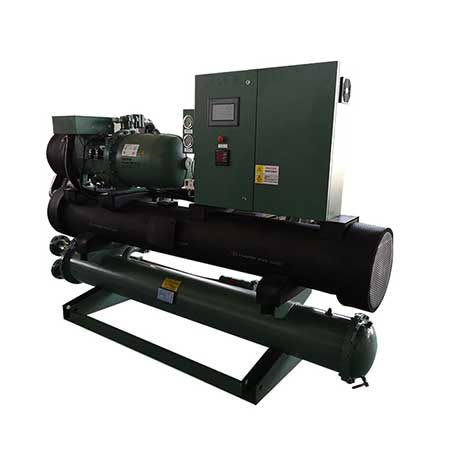
Chillers de parafuso (Desenhos personalizados)
Refrigeradores de parafuso a baixa temperatura e refrigeradores de parafuso a temperatura ambiente
| Gama de temperaturas | +5°C ~ +30°C | +5°C ~ +30°C | +5°C ~ +30°C | +5°C ~ +30°C | -25°C ~ +5°C | -25°C ~ +5°C |
| Capacidade de arrefecimento | 107 ~ 1027kW (Compressor único) | 299 ~ 2134kW (Compressor duplo) | 98 ~ 934kW (Compressor único) | 272 ~ 1940kW (Compressor duplo) | 48 ~ 467kW (Compressor único) | 51 ~ 497kW (Compressor simples) |
 LNEYA
LNEYA
 简体中文
简体中文












































































